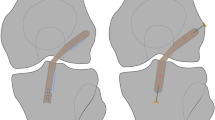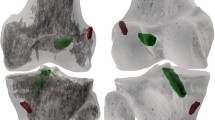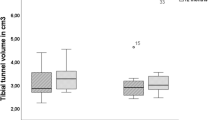Abstract
Purpose
This study tested the hypothesis that serial dilation of the tibial tunnel could provide a stronger anchorage of the graft-fixation-device complex compared to traditional extraction drilling.
Methods
Forty patients (22 men and 18 women) undergoing ACL reconstruction were randomized to either extraction drilling (group ED) or compaction by serial dilation (group SD) of the tibial tunnel. Tantalum beads were placed in the tibia, femur, and in the hamstring graft. Radiostereometric analysis (RSA) was performed postoperatively and again after 6, 12, and 24 weeks. Migration of graft in the bone tunnels as well as knee laxity was assessed using RSA and a TELOS stress device.
Results
Six patients (three men and three women) were excluded during follow-up, which resulted in 17 patients in group ED [median age 30 years (range 20–50)] and 17 patients in group SD [median age 32 years (range 20–49)]. The mean migration of the graft in the tibial bone canal after 3 months was 1.3 (SD 0.6) mm in group ED and 0.8 (SD 0.5) mm in group SD (P = 0.02). The overall knee laxity after 3 months was 13.0 (SD 4.0) mm in group ED and 10.9 (SD 3.1) mm in group SD.
Conclusion
This study found less slippage of the hamstring graft in the tibial bone canal in the serial dilated group compared to the extraction drilling group. The clinical relevance of the difference is unknown. No difference in stress radiographic knee laxity was found between the two groups.






Similar content being viewed by others
References
Brand JC Jr, Pienkowski D, Steenlage E, Hamilton D, Johnson DL, Caborn DN (2000) Interference screw fixation strength of a quadrupled hamstring tendon graft is directly related to bone mineral density and insertion torque. Am J Sports Med 28:705–710
Cain EL, Phillips BB, Charlebois SJ, Azar FM (2005) Effect of tibial tunnel dilation on pullout strength of semitendinosus-gracilis graft in anterior cruciate ligament reconstruction. Orthopedics 28:779–783
Duffee AR, Brunelli JA, Nyland J, Burden R, Nawab A, Caborn D (2007) Bioabsorbable screw divergence angle, not tunnel preparation method influences soft tissue tendon graft-bone tunnel fixation in healthy bone. Knee Surg Sports Traumatol Arthrosc 15:17–25
Dunkin BS, Nyland J, Duffee AR, Brunelli JA, Burden R, Caborn D (2007) Soft tissue tendon graft fixation in serially dilated or extraction-drilled tibial tunnels: a porcine model study using high-resolution quantitative computerized tomography. Am J Sports Med 35:448–457
Fleming BC, Peura GD, Abate JA, Beynnon BD (2001) Accuracy and repeatability of Roentgen stereophotogrammetric analysis (RSA) for measuring knee laxity in longitudinal studies. J Biomech 34:1355–1359
Friden T, Ryd L, Lindstrand A (1992) Laxity and graft fixation after reconstruction of the anterior cruciate ligament. A roentgen stereophotogrammetric analysis of 11 patients. Acta Orthop Scand 63:80–84
Gokce A, Beyzadeoglu T, Ozyer F, Bekler H, Erdogan F (2009) Does bone impaction technique reduce tunnel enlargement in ACL reconstruction? Int Orthop 33:407–412
Green JR, Nemzek JA, Arnoczky SP, Johnson LL, Balas MS (1999) The effect of bone compaction on early fixation of porous-coated implants. J Arthroplasty 14:91–97
Grover D, Thompson D, Hull ML, Howell SM (2006) Empirical relationship between lengthening an anterior cruciate ligament graft and increases in knee anterior laxity: a human cadaveric study. J Biomech Eng 128:969–972
Holden JP, Grood ES, Korvick DL, Cummings JF, Butler DL, Bylski-Austrow DI (1994) In vivo forces in the anterior cruciate ligament: direct measurements during walking and trotting in a quadruped. J Biomech 27:517–526
Johnson LL, vanDyk GE (1996) Metal and biodegradable interference screws: comparison of failure strength. Arthroscopy 12:452–456
Karrholm J, Selvik G, Elmqvist LG, Hansson LI, Jonsson H (1988) Three-dimensional instability of the anterior cruciate deficient knee. J Bone Joint Surg Br 70:777–783
Khan R, Konyves A, Rama KR, Thomas R, Amis AA (2006) RSA can measure ACL graft stretching and migration: development of a new method. Clin Orthop Relat Res 448:139–145
Kold S, Bechtold JE, Ding M, Chareancholvanich K, Rahbek O, Soballe K (2003) Compacted cancellous bone has a spring-back effect. Acta Orthop Scand 74:591–595
Kold S, Rahbek O, Toft M, Ding M, Overgaard S, Soballe K (2005) Bone compaction enhances implant fixation in a canine gap model. J Orthop Res 23:824–830
Kold S, Rahbek O, Vestermark M, Overgaard S, Soballe K (2005) Bone compaction enhances fixation of weightbearing titanium implants. Clin Orthop Relat Res 431:138–144
Kold S, Rahbek O, Vestermark M, Overgaard S, Soballe K (2006) Bone compaction enhances fixation of weight-bearing hydroxyapatite-coated implants. J Arthroplasty 21:263–270
Markolf KL, Slauterbeck JR, Armstrong KL, Shapiro MS, Finerman GA (1997) A biomechanical study of replacement of the posterior cruciate ligament with a graft. Part II: forces in the graft compared with forces in the intact ligament. J Bone Joint Surg Am 79:381–386
Noyes FR, Mangine RE, Barber S (1987) Early knee motion after open and arthroscopic anterior cruciate ligament reconstruction. Am J Sports Med 15:149–160
Nurmi JT, Kannus P, Sievanen H, Jarvela T, Jarvinen M, Jarvinen TL (2004) Interference screw fixation of soft tissue grafts in anterior cruciate ligament reconstruction: part 1: effect of tunnel compaction by serial dilators versus extraction drilling on the initial fixation strength. Am J Sports Med 32:411–417
Oh YH, Namkoong S, Strauss EJ, Ishak C, Hecker AT, Jazrawi LM, Rosen J (2006) Hybrid femoral fixation of soft-tissue grafts in anterior cruciate ligament reconstruction using the EndoButton CL and bioabsorbable interference screws: a biomechanical study. Arthroscopy 22:1218–1224
Richmond JC, Gladstone J, MacGillivray J (1991) Continuous passive motion after arthroscopically assisted anterior cruciate ligament reconstruction: comparison of short- versus long-term use. Arthroscopy 7:39–44
Rittmeister ME, Noble PC, Bocell JR Jr, Alexander JW, Conditt MA, Kohl HW III (2001) Interactive effects of tunnel dilation on the mechanical properties of hamstring grafts fixed in the tibia with interference screws. Knee Surg Sports Traumatol Arthrosc 9:267–271
Roos PJ, Hull ML, Howell SM (2004) Lengthening of double-looped tendon graft constructs in three regions after cyclic loading: a study using Roentgen stereophotogrammetric analysis. J Orthop Res 22:839–846
Roos PJ, Neu CP, Hull ML, Howell SM (2005) A new tibial coordinate system improves the precision of anterior-posterior knee laxity measurements: a cadaveric study using Roentgen stereophotogrammetric analysis. J Orthop Res 23:327–333
Rosen MA, Jackson DW, Atwell EA (1992) The efficacy of continuous passive motion in the rehabilitation of anterior cruciate ligament reconstructions. Am J Sports Med 20:122–127
Rupp S, Hopf T, Hess T, Seil R, Kohn DM (1999) Resulting tensile forces in the human bone-patellar tendon-bone graft: direct force measurement in vitro. Arthroscopy 15:179–184
Smith C, Hull ML, Howell SM (2008) Can markers injected into a single-loop anterior cruciate ligament graft define the axes of the tibial and femoral tunnels? A cadaveric study using roentgen stereophotogrammetric analysis. J Biomech Eng 130:044503
Smith C, Hull ML, Howell SM (2008) Roentgen stereophotogrammetric analysis methods for determining ten causes of lengthening of a soft-tissue anterior cruciate ligament graft construct. J Biomech Eng 130:041002
Smith CK, Hull ML, Howell SM (2005) Migration of radio-opaque markers injected into tendon grafts: a study using roentgen stereophotogrammetric analysis (RSA). J Biomech Eng 127:887–890
Sørensen OG, Jakobsen BW, Kold S, Hansen TB, Soballe K (2010) Serial dilation versus extraction drilling in anterior cruciate ligament reconstruction: a biomechanical study. Knee Surg Sports Traumatol Arthrosc 18:742–746
Tyler TF, McHugh MP, Gleim GW, Nicholas SJ (1998) The effect of immediate weightbearing after anterior cruciate ligament reconstruction. Clin Orthop Relat Res 357:141–148
Acknowledgments
The authors would like to thank Smith and Nephew for providing the instruments used for serial dilation during the study.
Conflict of interest
The authors declare that they have no conflict of interest.
Author information
Authors and Affiliations
Corresponding author
Rights and permissions
About this article
Cite this article
Sørensen, O.G., Larsen, K., Jakobsen, B.W. et al. Serial dilation reduces graft slippage compared to extraction drilling in anterior cruciate ligament reconstruction: a randomized controlled trial using radiostereometric analysis. Knee Surg Sports Traumatol Arthrosc 19, 347–354 (2011). https://doi.org/10.1007/s00167-010-1220-3
Received:
Accepted:
Published:
Issue Date:
DOI: https://doi.org/10.1007/s00167-010-1220-3




